With so many mobile C-arms available from numerous vendors who offer a wide variety of functionality and unique features, picking the right one for your facility can feel overwhelming. Start by collecting substantial feedback from your OR team and surgeons on what they're looking for from a clinical perspective, and also consider these important factors.
- Cost. I've bought several of these devices throughout my career, and you should start your search by determining how much you can, or want to, spend. You can go with brand-new C-arms, which can be quite expensive, or refurbished devices, which are available for less.
This year, we bought a secondhand C-arm and had issues with it. We'd purchased the machine, which was made by a well-known manufacturer, from a reseller. That company insured it for a year, but when the warranty expired, I had issues insuring the device with its original manufacturer, who made our facility's other C-arm and with whom our preventative maintenance staff and managers had solid relationships. The manufacturer checked out the C-arm and told us the reseller had made aftermarket modifications, including a larger screen that we liked, that needed to be removed before they would insure it. Fourteen thousand dollars later and after much related activity, the C-arm was insured. My point: It sometimes pays to buy new.
- Procedural mix. Our spine and pain management C-arms have nine-inch image intensifiers. But when we started doing hip replacements, we needed a 12-inch intensifier so our surgeons could look at both hip bones in one picture. The message here is to fully understand what you'll be using the C-arm for in order to zero in on the device that matches up best with your procedural priorities and budget.
- Image quality. Flat panel image detectors on newer machines provide higher-quality pictures, but the key is to protect everyone in the OR from radiation exposure while getting useful images. Most C-arms have low-dose modes that use the least amount of radiation for the best possible image. For example, C-arms with a pulsed-image feature are a safer option than models equipped for only continuous live imaging.
- Power draw. Most mobile C-arms need to be plugged into an electrical outlet, and the draw on that circuit is substantial when the devices are activated. A facility I once managed had two or three shared circuits in the OR. Randomly one day, the blanket warmer, C-arm, surgical microscope and other devices were all on the same circuit. When staff activated the C-arm, the circuit blew. Everyone thought it was a power outage, and waited for the generator to kick in, but nothing came on, so we had to race to the electrical room to reset the circuit.
When we built our newest surgery center, we included a dedicated plug and circuit for the C-arm, as well as a wall plug for uploading images to our digital integration system and ultimately to the cloud. (C-arms can store a limited number of images, so check both storage space and digital integration capabilities.)
- Upkeep. Even if you have your own X-ray techs, make sure to designate a nurse or surgical tech to be responsible for the machine, the required training and radiation safety education, weekly testing and general upkeep. Proper and consistent maintenance will extend the longevity of a C-arm.
A final point: If your C-arm goes down, cases will grind to a halt. It might be a good idea to purchase multiple units, so you'll always have a back-up available. OSM
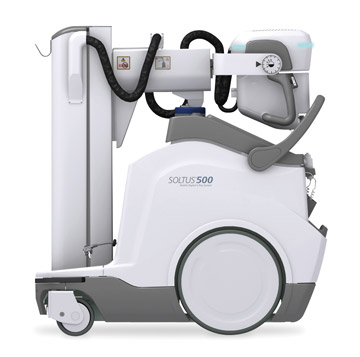
Canon Medical Systems USA
SOLTUS 500
800-421-1968
This flat-panel detector C-arm, powered by a standard 40kW generator, packs numerous features into a small footprint. A 19-inch touchscreen built into the tube head provides image previews and shows patient information,
and allows users to control pinch/zoom functionality. Handy integrated storage spaces can house disinfecting wipes, and a rear bin provides space for detector charging and storage. Software features include single-click image processing,
the ability to rotate images to any angle for optimal viewing and edge enhancement for better viewing of soft tissue. Pressure-sensitive steering and a telescoping column enhance maneuverability, and an anti-collision system employs
sensors located around the C-arm's front bumper that warn of approaching obstructions.
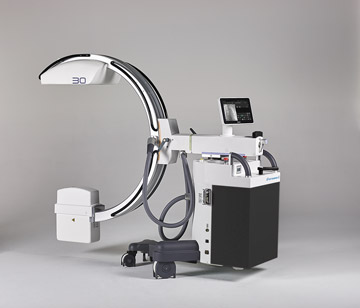
Fujifilm Medical
Systems U.S.A.
Persona C
203-951-8691
Designed for a broad range of diagnostic imaging and minimally invasive surgical procedures, this C-arm is available with 21cm x 21cm or 30cm x 30cm amorphous silicon (aSi) flat panel detectors for ultra-low-dose fluoroscopy.
Fujifilm stresses the unit's easy, precise navigation and imaging capabilities that include 81cm of free space for easy positioning around patients, a removable 8:1 grid for low-dose applications and a dedicated radiography mode for
high-quality still imaging. Images on its two 21.5-inch, fully height- and angle-adjustable touchscreen monitors can be manipulated from any side via a multi-touch console. Fujifilm says the C-arm's orbital and angular rotation responds
intuitively to operator touch and feel. Color-coded brakes and axis allow users to reposition the unit quickly, and easy-lift front wheels steer clear of floor obstacles.
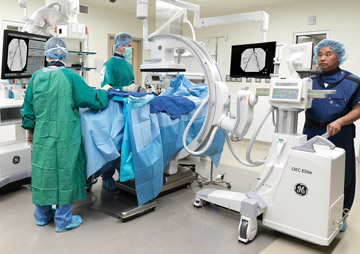
GE Healthcare
OEC Elite CFD
866-281-7545
GE touts this C-arm as being designed for intuitive control. Its large touchscreen, which can be located on the C-arm itself or on an optional roll stand, provides operator-friendly features, including familiar sequences
in a single tab menu selection. Its real-time 4x zoom feature enables users to focus on critical details on the fly with no change in X-ray technique. Its General HD imaging profile can "soften" bones and dense tissue, while enhancing
visualization of devices, enabling clinicians to perform procedural catheter insertions more easily.
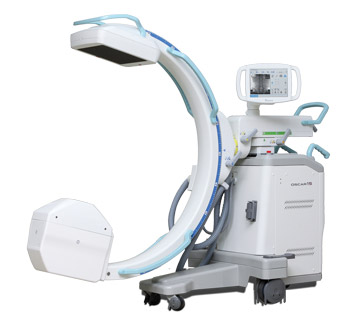
Genoray America
OSCAR 15
855-436-6729
This C-arm features a 26cm x 26cm flat panel detector with 800mm of free space and 150-degree dynamic orbital rotation. Its 15kW high-frequency generator with rotating tube is touted as allowing for longer usage during
surgeries. The C-arm's 10.4-inch touchscreen provides a user-friendly operation panel. A Low Dose Mode automatically adjusts the amount of radiation needed to capture optimal images based on procedure type and site. Auto and virtual
collimation settings further reduce unnecessary radiation exposure during image capture. Dual 19-inch monitors and a large 43-inch LCD monitor for visualization complete the package.
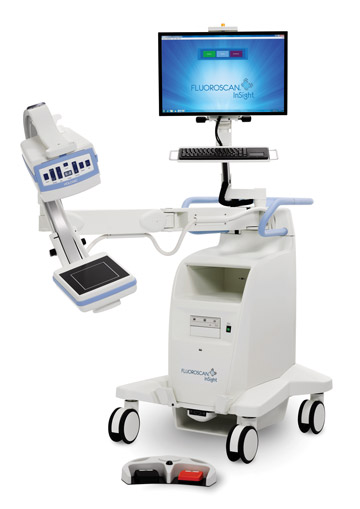
Hologic
Fluoroscan InSight FD
800-321-4659
Hologic says this C-arm's rotating flat panel detector increases imaging versatility for long bones and its low-dose option reduces radiation doses by over 50% while still providing clinically useful images. Clinicians
can expand image size by 50% on a tilting, pivoting 24-inch HD touchscreen display. Other features include pinch-to-zoom touchscreen controls and full 120-degree range of motion, which allows for added maneuverability and flexibility
around the patient and increased workspace access. Recent improvements to the platform include simplifying the method for locking the C-arm and reducing the system's total width in the locked position to save storage space.
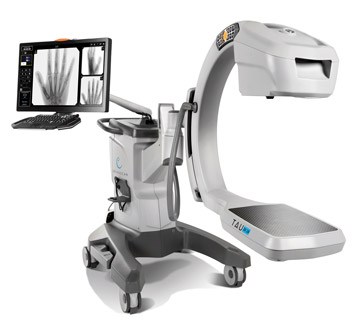
Orthoscan
TAU 2020
480-503-8010
This device blurs the line between mini and full-size C-arms. Sporting a large flat-panel detector — 20cm x 20cm — and a 27-inch touchscreen high-definition monitor, it’s heralded as the only mini C-arm
indicated for pediatric use. Its touchscreen interface includes onscreen help that describes common system functions, while its surgical LED lights eliminate shadows originating from the C-arm and staff. Its stepless, motorized collimator
— something usually found in fixed C-arms — can be adjusted through touchscreen controls. Other features include a multifunction wireless footswitch, backlit controls, three-way brake control for easier transport and integrated
cable pushers that protect power cords and other cables from damage.
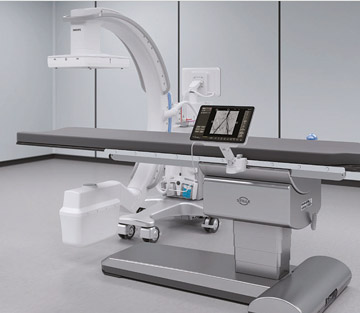
Philips Healthcare
Zenition 70
800-722-9377
The integrated smartphone-like touch-driven apps on this unit reside on a Windows platform, which enables high-speed wireless data transmission and means Philips can roll out changes and security upgrades to a whole fleet
of these C-arms at once. Philips says the C-arm's "point-and-shoot" design and on-screen guidance reduce the time and cost of staff training, making the system usable by clinicians of all experience levels. An optional 12.1-inch touchscreen
module, which boasts the same functionality as the C-arm's mounted screen and displays the same content as its Mobile View Station, increases the surgeon's table-side control during procedures. Using the module, surgeons can control
C-arm functions directly on the touchscreen, with the ability to select, drag and zoom images.
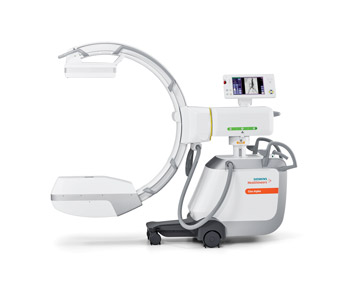
Siemens Medical Systems
Cios Alpha
888-826-9702
The Cios Alpha is a high-definition 2D mobile C-arm that leverages Retina technology seen in high-end smartphones to deliver optimal image quality, while its Combined Applications to Reduce Exposure (CARE) technologies
determine the proper dose for each case. The system's intelligent power management system includes an energy storage unit and active cooling to prevent overheating while maintaining power. Its anti-microbial surface and washable mouse
make cleaning and disinfection as easy as possible. Coming soon to the platform are new security functions to help minimize the risk of cyberattacks, including user management software to prevent unauthorized access.
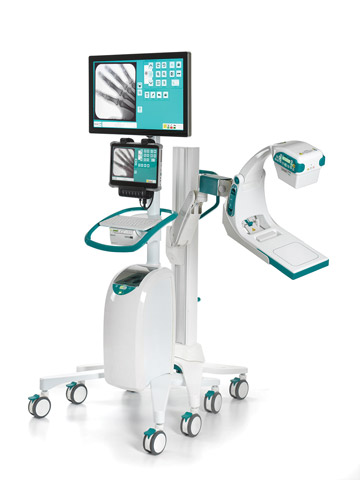
Turner Imaging Systems
Smart-C
866-870-2022
This battery-operated, cordless mini C-arm features a 27-inch touchscreen monitor and a six-by-six-inch imaging area with 100μm pixel resolution. Its CMOS flat panel detector, at 1.5 inches thick, is billed as the
thinnest on the market. The platform’s support stand and monitor cart, which includes locking wheels and a battery charger, can stand independently or be connected to act as a single unit for easy transport and storage. Other
features include a wireless tablet and footswitch, a durable carbon fiber frame, and software that automatically detects dense objects and adjusts contrast and brightness to optimize the image.
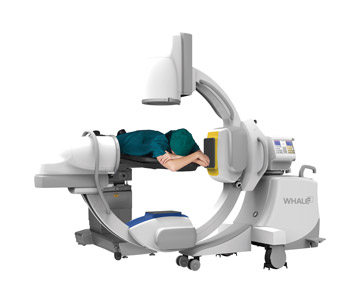
Whale Imaging
G-Arm B6 Duo
781-449-7200
The unique biplane design of this imaging system is well-suited for spine, orthopedic trauma and pain management procedures. Unlike conventional monoplane C-arms, the G-Arm allows users to capture antero- posterior and
lateral images simultaneously and in real time, removing the need for repeated articulation of the imaging gantry. Whale Imaging says this approach saves time, reduces cumulative radiation dosages and minimizes nosocomial infection
risk. Its real-time panoramic imaging option produces images in seconds rather than minutes, says the company, which plans to expand its G-Arm range this year with a flat panel version.
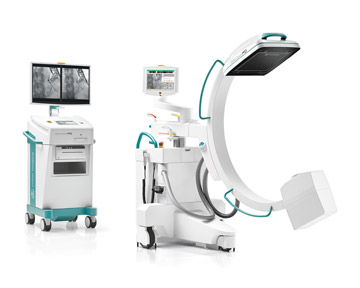
Ziehm Imaging
Vision FD
407-615-8560
Intended as a cost-effective, high-quality imaging option for outpatient facilities performing more complex procedures, this C-arm offers a choice between a 20.5cm x 20.5cm CMOS flat panel detector or a 31cm x 31cm amorphous
silicon (aSi) flat panel detector. Its liquid cooling system, paired with a 2.4kW pulsed monoblock generator, extends continuous use. Other characteristics and features touted by Ziehm include low noise levels, clear magnifications
and enhanced dose management that provides high-quality images with minimized radiation doses.
.svg?sfvrsn=be606e78_3)
.svg?sfvrsn=56b2f850_5)